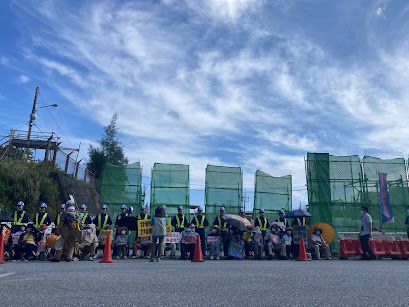Updates on our inquiry efforts regarding Henoko and Yambaru Forest
Henoko New Base Construction
In November last year, we informed our readers that OEJP obtained a copy of U.S. U.S. Congressman James Moylan's letter sent to the Government Accountability Office in June last year regarding the Henoko new base construction project. The letter questioned the Japanese court's and government's decisions to approve "by proxy execution" design changes for the project. It requested that the GAO conduct an expert and independent study on seven specific issues, including "an assessment of whether the soft seabed and the planned ground reinforcement work will affect the U.S. Marines' future operations at the facility."
In November last year, we informed our readers that OEJP obtained a copy of U.S. U.S. Congressman James Moylan's letter sent to the Government Accountability Office in June last year regarding the Henoko new base construction project. The letter questioned the Japanese court's and government's decisions to approve "by proxy execution" design changes for the project. It requested that the GAO conduct an expert and independent study on seven specific issues, including "an assessment of whether the soft seabed and the planned ground reinforcement work will affect the U.S. Marines' future operations at the facility."
In February this year, we contacted the GAO and asked whether it had completed its study and, if so, whether it could provide us with information. The GAO replied that it "did not have additional information to share at this time" and recommended that we "contact Representative Moylan's office for additional insight."
We appreciate the GAO's prompt response and suggestion. We will follow the GAO's recommendation soon.
We reported on our Facebook page that "The United States-Japan Leaders' Statement," released by President Donald Trump and Prime Minister Ishiba Shigeru on February 7, dropped the wording "the Futenma Replacement Facility at Henoko (Henoko new base construction) as the only solution," which was used in previous leaders' statements. In this emerging context, obtaining information on how the U.S. government regards the prospect of this absurd plan is more crucial than ever.
UNESCO World Heritage Site Yambaru Forest and U.S. Military's Northern Training Area
In December last year, OEJP sent a Freedom of Information Request letter to the Dutch Defense Ministry and the U.K. Defense Ministry regarding their armed forces' participation in training with the U.S. military in the Northern Training Area (NTA) in Okinawa, Japan. We requested they provide information on whether they took any environmental protection training and measures during their time in the NTA because the NTA is located next to the UNESCO World Heritage site, "Northern Part of Okinawa Island."
In December last year, OEJP sent a Freedom of Information Request letter to the Dutch Defense Ministry and the U.K. Defense Ministry regarding their armed forces' participation in training with the U.S. military in the Northern Training Area (NTA) in Okinawa, Japan. We requested they provide information on whether they took any environmental protection training and measures during their time in the NTA because the NTA is located next to the UNESCO World Heritage site, "Northern Part of Okinawa Island."
Since we had not received a reply from either Ministry, in March, we contacted and requested that the Dutch and U.K. UNESCO Commissions and their embassies in Tokyo encourage their Defense Ministries to provide information. The Dutch UNESCO Commission replied that it had forwarded our request to its contacts at the Defense Ministry.
We appreciate the Dutch UNESCO Commission's reply and swift action. We hope that the U.K. Commission also takes action. We hope to get information from both ministries soon so that we can include their information in our report and request to the UNESCO World Heritage Centre and IUCN.



